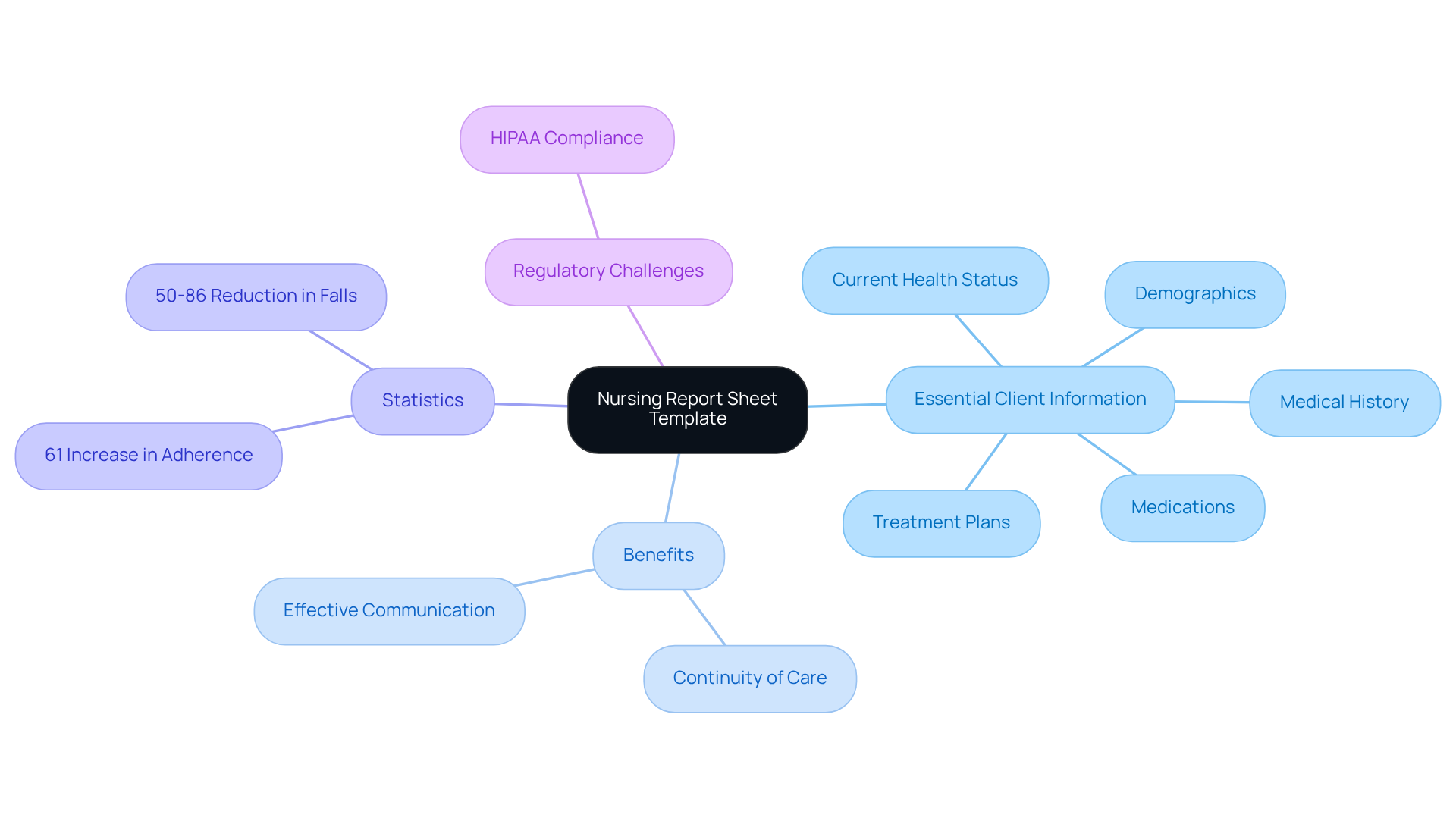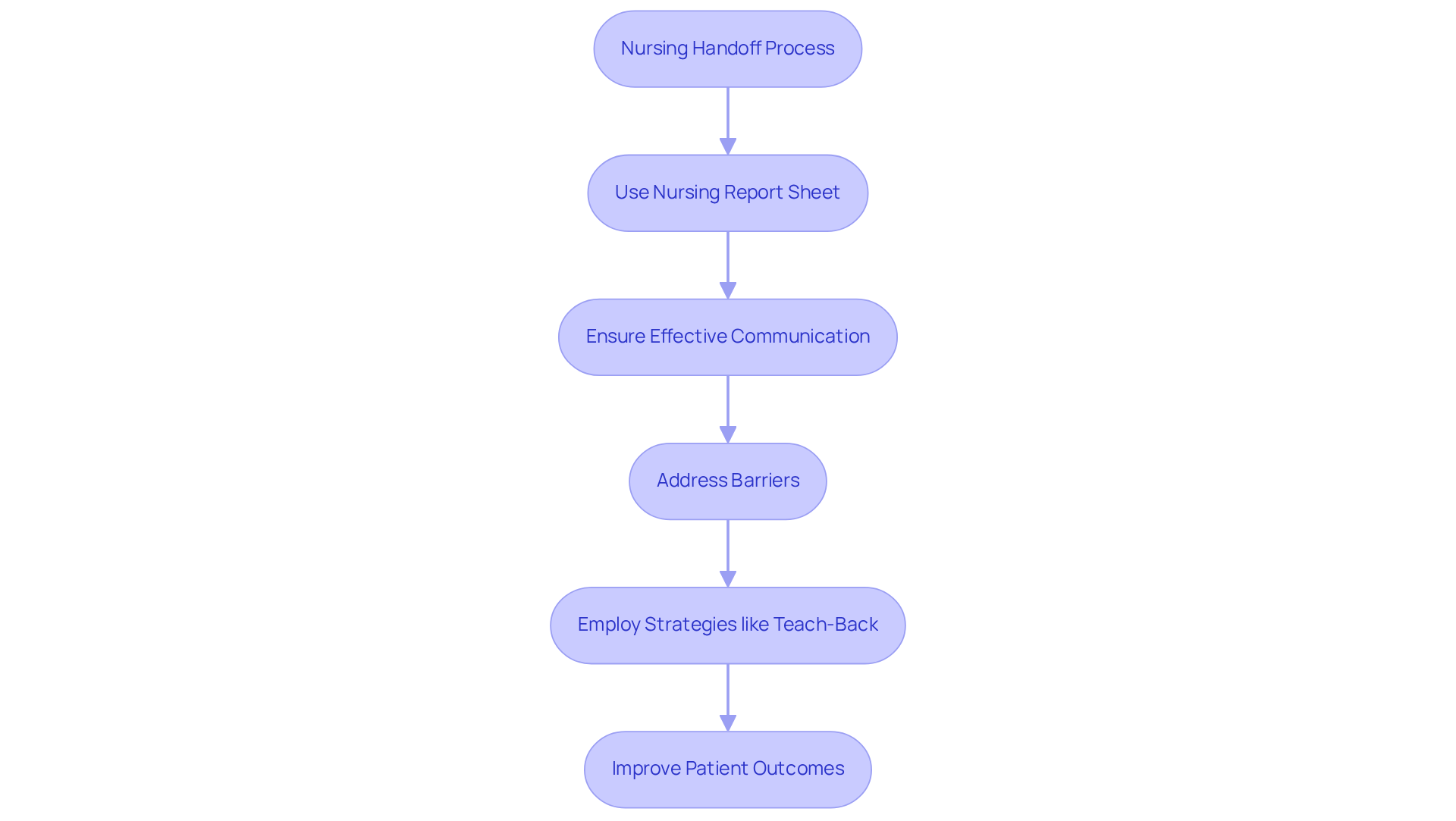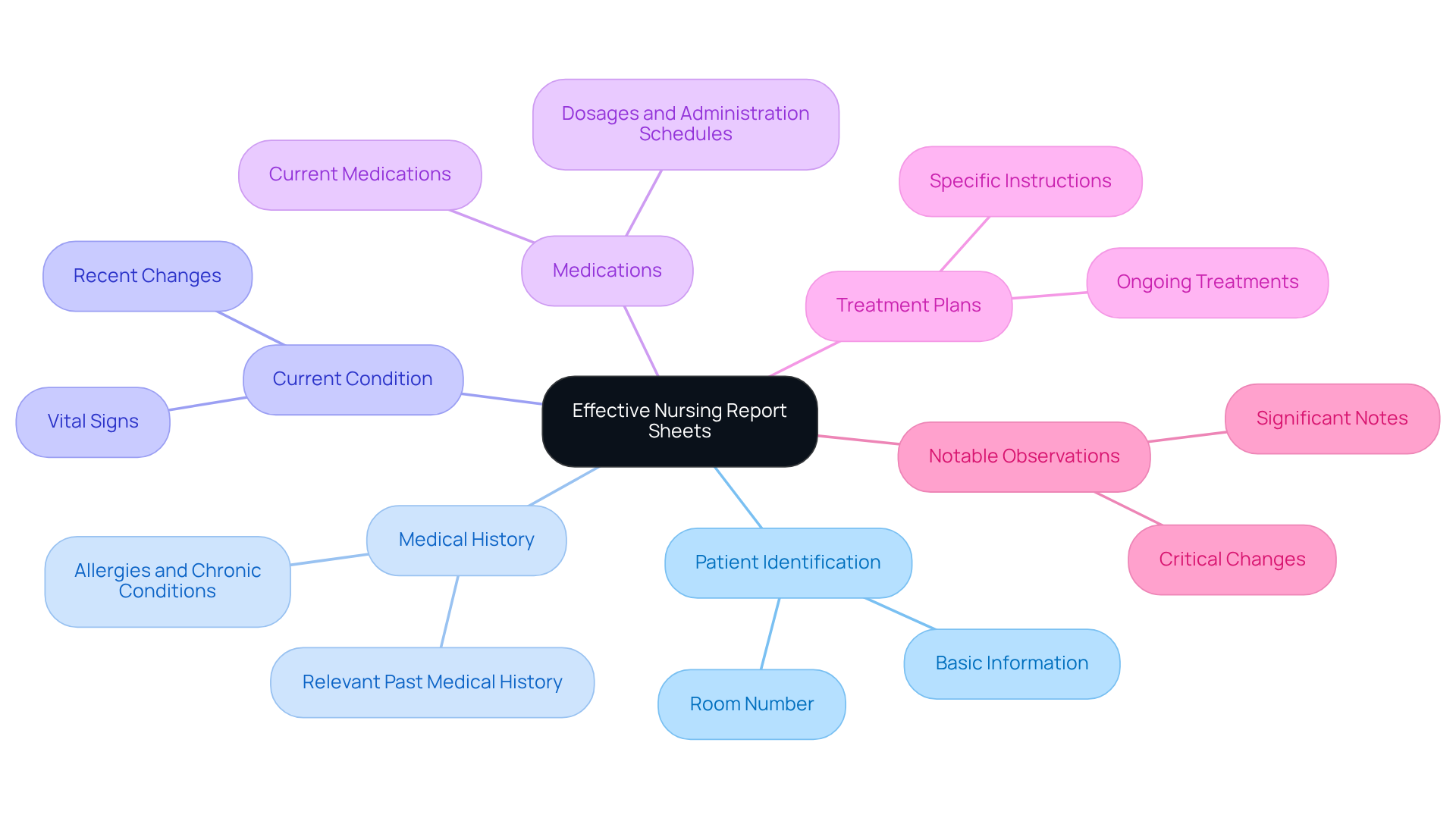Overview
In the demanding world of healthcare, the nursing report sheet template stands as a vital tool for effective patient care. It not only standardizes the transfer of critical information during shift changes but also enhances communication among healthcare providers.
Have you ever felt the weight of ensuring seamless information exchange? Using such templates can significantly alleviate that burden, as studies have shown that they reduce errors and improve patient outcomes. This is especially true with increased adherence to bedside shift reports and a notable decrease in fall rates among patients.
By embracing this approach, we can foster a safer and more caring environment for those we serve.
Introduction
The nursing report sheet template serves as more than just a piece of paper; it stands as a cornerstone of effective patient care, ensuring seamless communication during critical shift changes. By systematically organizing essential patient information, these templates not only enhance safety and reduce errors but also empower healthcare professionals to deliver the high-quality support that every patient deserves.
Yet, as the healthcare landscape grows increasingly complex, many nurses face emotional challenges. How can they navigate the burdens of fragmented communication and administrative tasks to provide the attentive care their patients need?
Understanding these challenges is crucial. Administrative burdens can weigh heavily on healthcare providers, often detracting from the time and energy they wish to devote to patient care. As we explore solutions, it becomes clear that effective communication tools, like nursing report sheet templates, can significantly alleviate these pressures.
Imagine a world where every nurse feels equipped to focus on their patients without the stress of disorganization. By embracing these templates, healthcare professionals can foster a nurturing environment that prioritizes patient well-being.
Let’s reflect on this: How can we all contribute to a smoother, more compassionate care experience? Together, we can ensure that every patient receives the attentive care they deserve.
Define Nursing Report Sheet Template
A nursing report sheet template is not just a document; it’s a lifeline for nurses striving to provide the best care possible during shift changes. This vital tool systematically captures essential client information, including demographics, medical history, current health status, medications, and treatment plans. By standardizing this information, the nursing report sheet template becomes crucial in ensuring continuity of support and fostering effective communication among healthcare professionals.
Have you ever felt the weight of administrative burdens impacting your ability to care for patients? This method simplifies the handoff process between shifts, significantly enhancing safety for individuals. In fact, studies show a remarkable 61% increase in adherence to bedside shift reports (BSR) and a reduction in falls among individuals by 50% to 86% after implementation.
In our often disjointed healthcare systems, where patient support can be fragmented among various providers, the use of a nursing report sheet template becomes even more essential. They bridge information gaps, ensuring that all providers are informed and coordinated in their care efforts. Furthermore, regulatory challenges like HIPAA can complicate communication, making organized tools such as a nursing report sheet template indispensable. These tools help reduce the risk of mistakes and omissions, ultimately promoting a safer healthcare environment.
Let’s continue to prioritize compassionate care by embracing these vital resources. Together, we can create a more cohesive and supportive healthcare experience for everyone involved.

Context and Importance in Patient Care
The nursing report sheet template plays a vital role in the nursing process, especially during shift transitions when crucial client information needs to be shared effectively. These documents provide a concise overview of a patient's condition, ensuring that incoming nurses have immediate access to essential information. This practice not only fosters collaboration among healthcare professionals but also nurtures a culture of safety by minimizing the risk of misunderstandings or mistakes.
Have you ever considered how inadequate interactions can lead to significant issues in healthcare settings? Research indicates that such interactions contribute to approximately 70-80% of mistakes in these environments. This highlights the critical need for efficient transitions supported by a nursing report sheet template. For instance, organized handoff procedures have been shown to reduce information loss and ensure continuity of care, as demonstrated in the 'Improve Patient Handoffs' case study.
Moreover, effective communication can significantly enhance patient outcomes. Studies reveal that patients who engaged in post-discharge outreach calls experienced a 56% reduction in readmission rates. By embracing best practices in nursing handoff interactions, including strategies like the teach-back method, healthcare providers can cultivate a more efficient and safer environment. However, it’s important to recognize and address potential obstacles, such as cultural differences and language barriers.
Together, let’s work towards improving our handoff processes to ensure that every patient receives the care and attention they deserve.

Key Components of Effective Nursing Report Sheets
Effective nursing report sheet templates are essential tools for ensuring seamless communication among healthcare providers. They play a crucial role in alleviating the emotional challenges that arise in fast-paced healthcare environments. By providing a clear structure, these sheets help reduce the administrative burdens that can detract from patient care. Key components include:
- Patient Identification: This section should contain basic information such as the patient's name, age, gender, and room number, which is vital for accurate identification and care continuity.
- Medical History: A summary of relevant past medical history, including allergies and chronic conditions, helps inform treatment decisions and avoid potential complications.
- Current Condition: A concise overview of the individual's current health status, including vital signs and any recent changes, is essential for monitoring and responding to individual needs.
- Medications: A detailed list of current medications, dosages, and administration schedules ensures that all providers are aware of the individual's pharmacological regimen, reducing the risk of errors.
- Treatment Plans: Clear documentation of ongoing treatments and specific instructions assists healthcare providers in delivering consistent and effective support.
- Notable Observations: Significant notes or observations that may influence individual treatment should be included to inform providers of any critical changes or considerations.
By including these elements, the nursing report sheet template promotes efficient interaction, guaranteeing that all healthcare providers are well-informed and ready to provide high-quality assistance. This organized method not only improves safety for individuals but also encourages teamwork among the healthcare group.
Considering the anticipated nursing deficit, requiring over 200,000 additional RNs annually, effective dialogue is increasingly vital in ensuring high-quality treatment. As the American Nursing Association highlights, "Effective interaction is crucial for safety and quality service."
Moreover, utilizing AI solutions such as those provided by CosmaNeura can simplify administrative tasks, including automated documentation and real-time updates. This enables nurses to concentrate more on patient care and efficient interaction, ultimately transforming patient care and easing the challenges encountered by healthcare providers.
In these demanding times, let us remember the importance of compassionate communication in fostering a supportive healthcare environment.

Examples and Variations of Nursing Report Sheets
Nursing report sheet templates serve as vital tools in clinical practice, designed to cater to specific needs with compassion. Among these, the SBAR format—comprising Situation, Background, Assessment, and Recommendation—shines for its structured approach to sharing crucial information. This method not only enhances clarity but also reduces misunderstandings, addressing a significant concern, as failures in communication contribute to over 60% of hospital adverse events. Research indicates that adopting SBAR can markedly improve safety and satisfaction during handoffs. Remarkably, 72.6% of nurses assessed displayed good or high proficiency with SBAR, highlighting its effectiveness in clinical settings. Dr. Martin Müller notes that 'the SBAR tool is seen as a communication method that enhances safety and is the current ‘best practice’ for conveying information in critical situations.'
In addition to SBAR, formats like Brain Sheets allow nurses to manage multiple patients' information on a single page, which is especially beneficial in high-acuity environments such as ICUs. Specialty-specific documents are also prevalent, featuring tailored templates for areas like pediatrics or oncology, ensuring that vital information is readily accessible for those specific groups.
The shift towards digital templates is gaining momentum, with many healthcare facilities adopting electronic nursing report forms that integrate seamlessly with electronic health records (EHRs). This transition not only facilitates real-time updates but also enhances access to individual information, streamlining workflows for nursing staff. Yet, challenges such as inconsistent uptake across facilities and a lack of physician education may impede the effective implementation of SBAR. The flexibility of these nursing report sheet templates empowers nurses to select or customize the nursing report sheet template that best aligns with their clinical practices and patient care needs, ultimately elevating the quality of care provided.

Conclusion
The nursing report sheet template is an essential resource in the healthcare landscape, acting as a structured tool that enhances communication and continuity of care during shift transitions. By systematically organizing crucial patient information, these templates empower nurses to provide high-quality care, reducing the risks associated with information loss and misunderstandings.
Have you ever considered the emotional challenges that healthcare providers face during handoff processes? Effective nursing report sheets are vital for fostering collaboration among healthcare providers and ensuring safety in patient care. Key components such as:
- Patient identification
- Medical history
- Current condition
- Medications
- Treatment plans
- Notable observations
are crucial for promoting seamless interactions. Furthermore, the adoption of structured formats like SBAR and the transition to digital templates significantly enhance the efficacy of these tools, showcasing their adaptability to various clinical needs.
Ultimately, embracing the nursing report sheet template not only streamlines communication but also nurtures a more supportive and compassionate healthcare environment. As the demand for nursing professionals continues to rise, prioritizing effective handoff processes and communication strategies will be paramount in ensuring that every patient receives the attentive care they deserve. By committing to utilizing these vital resources, we can foster improved patient outcomes and create a more cohesive healthcare experience for everyone involved.




